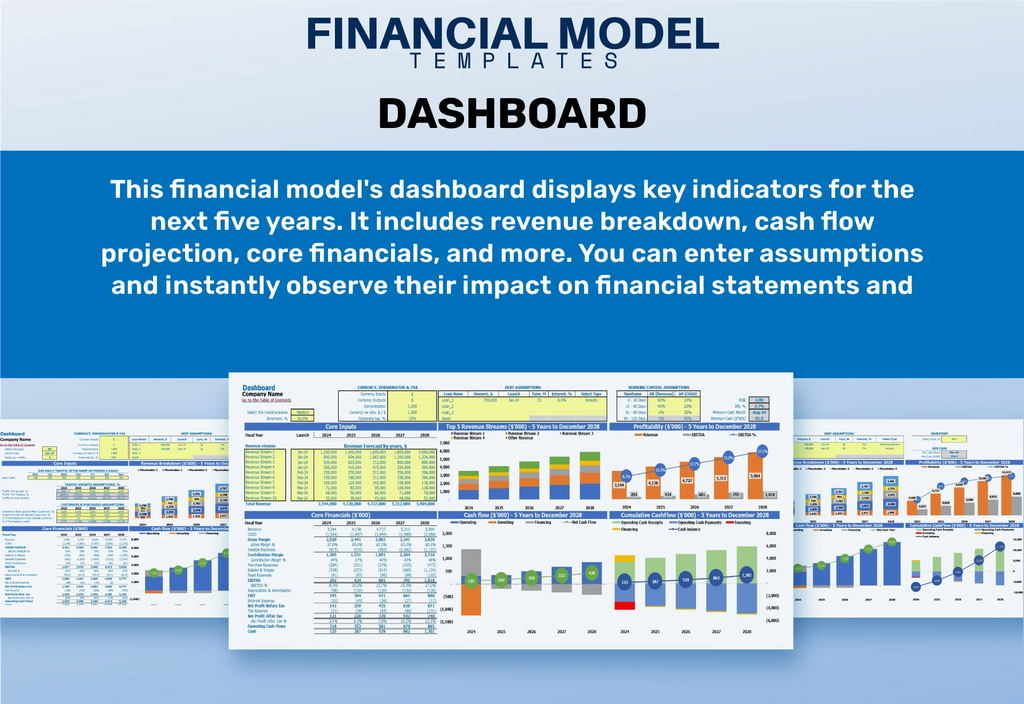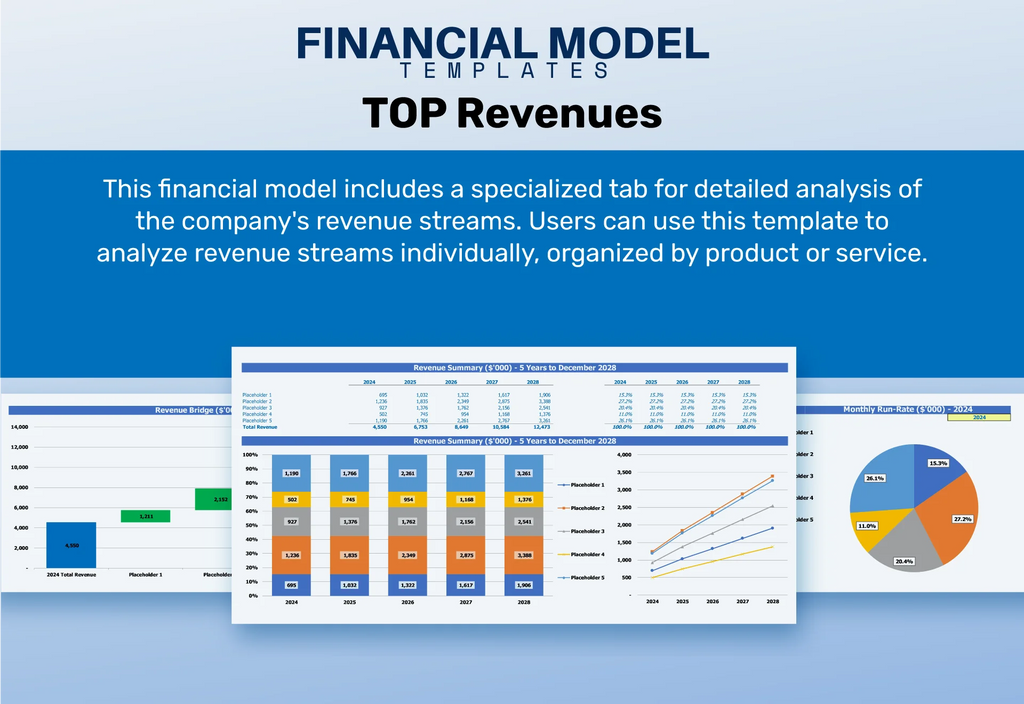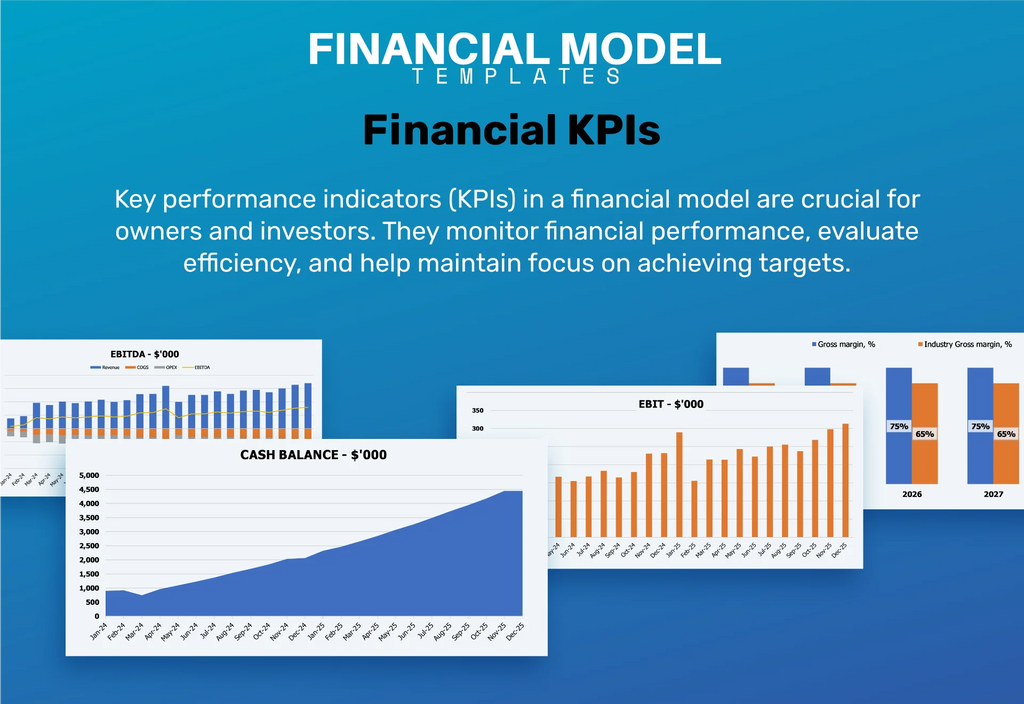Freight Consolidation Financial Model

- ✔ 5-Year Financial Projections
- ✔ 100% Editable
- ✔ Investor-Approved Valuation Models
- ✔ MAC/PC Compatible, Fully Unlocked
- ✔ No Accounting Or Financial Knowledge
Freight Consolidation Financial Model
Bundle Includes:
ALL IN ONE MEGA PACK - CONSIST OF:
freight consolidation Financial Model/Business Plan Excel Template
Pitch Deck Template For PowerPoint, Keynote & Google Slides
Business Plan Guide and Business Plan Template in MS Word Format
Financial Dashboard in Excel To Track Your Business Performance
FREIGHT CONSOLIDATION FINANCIAL MODEL FOR STARTUP INFO
Highlights
Developing a five-year business plan for freight consolidation strategies is essential for early-stage startups aiming to impress investors and secure capital. Utilizing logistics financial modeling will help evaluate startup ideas while incorporating cost reduction techniques and transportation cost analysis to effectively manage expenses. By implementing supply chain optimization and warehouse consolidation, businesses can enhance operational efficiency and maximize shipping efficiency improvement. Furthermore, integrating data analytics in supply chain management and financial forecasting in logistics allows for better inventory management strategies and profitability analysis in freight. Embracing multimodal transportation solutions and capacity planning in transportation can drive economies of scale in logistics, ultimately leading to a robust distribution network optimization and effective load optimization strategies that mitigate risks and improve overall performance.
The ready-made financial model in Excel template effectively addresses key pain points for buyers by integrating comprehensive freight consolidation strategies and logistics financial modeling, empowering startups to optimize their supply chain through cost reduction techniques and transportation cost analysis. With functionality for warehouse consolidation and inventory management strategies, it promotes operational efficiency in freight while enhancing shipping efficiency improvement through load optimization strategies. Furthermore, the template incorporates robust financial forecasting in logistics, allowing users to perform profitability analysis in freight and conduct capacity planning in transportation. It leverages data analytics in supply chain for informed decision-making, ensuring thoughtful freight cost allocation and driving distribution network optimization to harness economies of scale in logistics, ultimately solving critical challenges faced by startups in achieving effective risk management in freight operations.
Description
The freight consolidation 3-statement financial model template is essential for starting your own logistics business and ensuring you remain financially vigilant while seeking to optimize supply chain operations. This comprehensive model allows you to analyze revenue generation, assess cost reduction techniques, and perform transportation cost analysis, ensuring that cash flow is accurately calculated and monitored. Developed by financial analysts, the template outlines necessary expenses and investment requirements for launching a freight consolidation venture, complete with a 5-year financial projection that supports operational efficiency and profitability analysis in freight. This tool also encompasses key metrics such as financial ratios, investment coverage ratios, and insights into economies of scale in logistics, making it a vital resource for enhancing shipping efficiency and capacity planning in transportation.
FREIGHT CONSOLIDATION FINANCIAL MODEL REPORTS
All in One Place
Enhance your logistics strategy with our comprehensive freight consolidation proforma business plan template. This sophisticated Excel financial model offers a clear roadmap for diverse business models, facilitating effective capacity planning in transportation and cost reduction techniques. Even those with basic financial knowledge can easily customize the various sheets to meet their needs. Leverage its capabilities for supply chain optimization, shipping efficiency improvement, and operational efficiency in freight, ensuring you capitalize on economies of scale in logistics and streamline your distribution network. Elevate your freight management and drive profitability with our user-friendly solution.

Dashboard
The financial dashboard in this projection template serves as an essential tool for logistics financial modeling. It consolidates key performance indicators (KPIs), enabling efficient tracking of expenses, sales, and profits against your financial goals. By leveraging data analytics in supply chain management, this dashboard enhances operational efficiency in freight and supports comprehensive financial forecasting. With an intuitive interface, you can easily share insights on your company’s financial health with stakeholders, ensuring they stay informed of your logistics strategies, including freight consolidation and cost reduction techniques. Optimize your distribution network and drive profitability with this powerful resource.

Business Financial Statements
Our comprehensive financial model template in Excel is designed for the logistics industry, featuring fully integrated pro forma statements, including profit and loss forecasts, projected balance sheets, and cash flow formats. This user-friendly tool enables you to conduct detailed freight cost allocation, transportation cost analysis, and profitability analysis in freight. Present data on a monthly or annual basis and seamlessly integrate existing financial statements from platforms like QuickBooks and Xero to enhance your financial forecasting in logistics. Optimize your supply chain performance with insightful data analytics and operational efficiency strategies for improved decision-making.

Sources And Uses Statement
The sources and uses page of the three-statement financial model template provides critical insights into a company’s financial management. By highlighting key financial sources and expenditure, it serves as a foundation for effective logistics financial modeling. This is especially vital for start-ups, enabling them to implement cost reduction techniques and optimize their supply chain. Understanding financial flows supports risk management in freight and enhances operational efficiency. As businesses strive for profitability, this analysis aids in capacity planning, supporting informed decision-making for both freight consolidation strategies and multimodal transportation solutions.

Break Even Point In Sales Dollars
This Excel report presents a comprehensive break-even analysis, pinpointing the annual revenue required for the company to achieve financial equilibrium. Utilizing both variable and fixed cost data, this tool empowers logistics decision-makers to enhance operational efficiency in freight and refine inventory management strategies. Additionally, the report can be adapted to reveal the timeline in months necessary to reach break-even, aiding in strategic capacity planning and risk management in freight. Leverage insights from this analysis for improved shipping efficiency and cost reduction techniques, ultimately driving profitability within your supply chain optimization efforts.

Top Revenue
This financial modeling template provides a dedicated tab for in-depth analysis of your company’s revenue streams. Users can efficiently conduct a profitability analysis in freight by categorizing revenue by product or service. By leveraging data analytics in supply chain and utilizing cost reduction techniques, this tool supports strategic freight consolidation strategies to enhance overall operational efficiency. Additionally, the customizable layout allows for improved financial forecasting in logistics, enabling businesses to optimize their distribution network and achieve economies of scale. Streamline your revenue analysis and drive better decision-making for sustained growth.

Business Top Expenses Spreadsheet
Understanding your business's financial landscape is crucial for effective supply chain optimization. Our structured financial forecasting model highlights annual expenses through the Top Expenses tab, divided into four detailed categories—encompassing customer acquisition costs and fixed expenditures. This approach facilitates transportation cost analysis and enables better freight cost allocation. By gaining insights into spending origins, you can implement cost reduction techniques and enhance operational efficiency in freight, ultimately driving profitability. Take control of your logistics financial modeling to achieve your strategic goals and improve shipping efficiency.

FREIGHT CONSOLIDATION FINANCIAL PROJECTION EXPENSES
Costs
Effective management of start-up costs is vital for any logistics business. Monitoring these expenses early ensures optimal funding and prevents overspending. Our freight consolidation financial projections spreadsheet offers a comprehensive proforma to track both funding and expenditures, aligning with key logistics financial modeling principles. Utilize this tool to implement cost reduction techniques, optimize your distribution network, and enhance operational efficiency in freight. By keeping a close eye on your budget, you can strategically improve shipping efficiency and achieve economies of scale, setting the foundation for long-term success in your supply chain optimization efforts.

CAPEX Spending
Capital expenditures (CAPEX) play a pivotal role in logistics financial modeling, as they directly impact cash flow and overall profitability analysis in freight. Financial experts meticulously establish startup budgets, tracking investments to ensure operational efficiency. Understanding startup expenditures is essential for effective capacity planning and value chain analysis in logistics. By accurately forecasting these costs, businesses can optimize supply chain strategies and enhance shipping efficiency, ultimately leading to improved financial performance. A cautious approach to initial budgeting is vital for achieving sustainable growth and leveraging economies of scale in logistics.

Loan Financing Calculator
Our comprehensive financial modeling for logistics includes a built-in loan amortization plan, calculating both principal and interest. With our customizable amortization schedule template, you can optimize cash flow and enhance operational efficiency in freight. This tool accounts for the principal amount, interest rate, loan term, and payment frequency, ensuring precise financial forecasting. By leveraging these insights, businesses can implement effective cost reduction techniques and supply chain optimization strategies, ultimately leading to improved shipping efficiency and long-term profitability in the logistics sector.

FREIGHT CONSOLIDATION EXCEL FINANCIAL MODEL METRICS
Financial KPIs
Enhance your company’s financial health and operational efficiency in freight by tracking essential key performance indicators (KPIs). Utilizing logistics financial modeling, you can visualize critical metrics through dynamic graphs. This approach aids in freight consolidation strategies and cost reduction techniques, driving supply chain optimization. Leverage data analytics in supply chain management for effective inventory management strategies and transportation cost analysis. By implementing financial forecasting in logistics, you can achieve economies of scale and improve shipping efficiency, ultimately maximizing profitability through informed decision-making in your distribution network.

Cash Flow Forecast Excel
A robust cash flow forecast is vital for effective logistics financial modeling. This forecast categorizes cash flows into operating, investing, and financing activities, ensuring alignment with the pro forma balance sheet. By accurately reconciling these elements, businesses can enhance their profitability analysis in freight and supply chain optimization efforts. Each line item in the cash flow statement interrelates with the overall financial model, driving operational efficiency in freight management. By incorporating data analytics in supply chain and freight cost allocation, companies can implement cost reduction techniques that improve shipping efficiency and achieve economies of scale.

KPI Benchmarks
A comprehensive startup financial model template incorporates industry analysis through a rigorous comparison of financial indicators. This benchmarking process offers valuable insights into your company’s performance relative to industry standards, enhancing your logistics financial modeling. By leveraging data analytics in supply chain optimization, you can identify opportunities for cost reduction techniques and operational efficiency in freight. Ultimately, informed financial forecasting in logistics will guide your decision-making, while strategies like freight consolidation and warehouse optimization can lead to significant improvements in shipping efficiency and profitability analysis in freight.

P&L Statement Excel
Navigating the complexities of accounting, particularly in profit and loss projection, can be daunting for businesses. Our ready-to-use pro forma profit and loss statement template simplifies this process, ensuring accurate financial forecasting in logistics. With our expertise, you can seamlessly integrate key elements like freight consolidation strategies, cost reduction techniques, and inventory management strategies into your financial modeling. This empowers your operations by enhancing shipping efficiency, optimizing your distribution network, and improving overall operational efficiency in freight. Elevate your financial planning with our user-friendly template and unlock the potential for greater profitability analysis in freight.

Pro Forma Balance Sheet Template Excel
The pro forma balance sheet offers a comprehensive snapshot of your financial projections, detailing assets, liabilities, and equity accounts. This tool is essential for effective logistics financial modeling, enabling supply chain optimization and informed decision-making. By leveraging data analytics in supply chain management, organizations can enhance operational efficiency and implement cost reduction techniques. A clear understanding of financial forecasting in logistics will empower businesses to optimize their distribution networks and improve shipping efficiency, ultimately supporting profitability analysis in freight and fostering sustainable growth through economies of scale.

FREIGHT CONSOLIDATION FINANCIAL PROJECTION TEMPLATE VALUATION
Startup Valuation Model
This freight consolidation financial plan template features a comprehensive valuation analysis tool, enabling users to conduct Discounted Cash Flow (DCF) valuations seamlessly. It empowers logistics professionals to optimize supply chain efficiency by integrating key financial metrics, including residual value, replacement costs, and market comparables. By utilizing this template, users can enhance their profitability analysis in freight, improve operational efficiency, and implement effective cost reduction techniques. Leverage data analytics in supply chain management to refine your financial forecasting and gain insights that drive strategic decision-making in your logistics operations.

Cap Table
A cap table is vital for startups, offering insights into investments, shareholder distribution, and financial resource limitations. It serves as a crucial tool in logistics, facilitating effective financial modeling and forecasting. By analyzing ownership structures, startups can optimize their supply chain strategies, enhance shipping efficiency, and implement cost reduction techniques. With data analytics, companies can refine their distribution network and improve operational efficiency, ultimately driving profitability. A well-managed cap table not only clarifies financial standing but also supports strategic decisions in inventory management and freight cost allocation.

KEY FEATURES
Effective logistics financial modeling enhances shipping efficiency improvements and drives cost reduction techniques, boosting overall supply chain profitability.
Utilizing financial modeling in logistics enhances profitability analysis in freight, enabling informed decision-making and improved operational efficiency.
Implementing logistics financial modeling enhances supply chain optimization, enabling cost reduction through effective freight consolidation strategies and transportation cost analysis.
Our Excel template streamlines financial modeling for freight consolidation, saving time while meeting lender requirements effortlessly.
Effective logistics financial modeling enhances shipping efficiency improvements and drives cost reduction techniques, boosting overall supply chain profitability.
Adjusting inputs in your financial model enhances freight consolidation strategies, driving operational efficiency and cost reduction throughout your logistics processes.
Implementing logistics financial modeling enhances profitability analysis in freight, driving operational efficiency and cost reduction strategies for startups.
The Startup Financial Model Template enhances logistics financial modeling, enabling clear insights for effective decision-making and strategic planning.
Implementing logistics financial modeling enhances supply chain optimization, leading to significant cost reductions and improved operational efficiency in freight.
Unlock efficient supply chain optimization and cost reduction with our seamless financial model template, eliminating unnecessary complexities and focusing on results.
ADVANTAGES
The financial forecasting model enhances operational efficiency in freight by revealing strengths and weaknesses for improved decision-making.
Harnessing financial modeling for freight consolidation empowers businesses to optimize costs and enhance profitability through strategic decision-making.
Implementing financial modeling in logistics enhances freight consolidation strategies, driving cost reductions and improving overall operational efficiency.
Unlock competitive advantages with logistics financial modeling that enhances supply chain optimization and improves cost reduction techniques.
Effective logistics financial modeling enhances cost reduction techniques and boosts shipping efficiency improvement across your supply chain.




